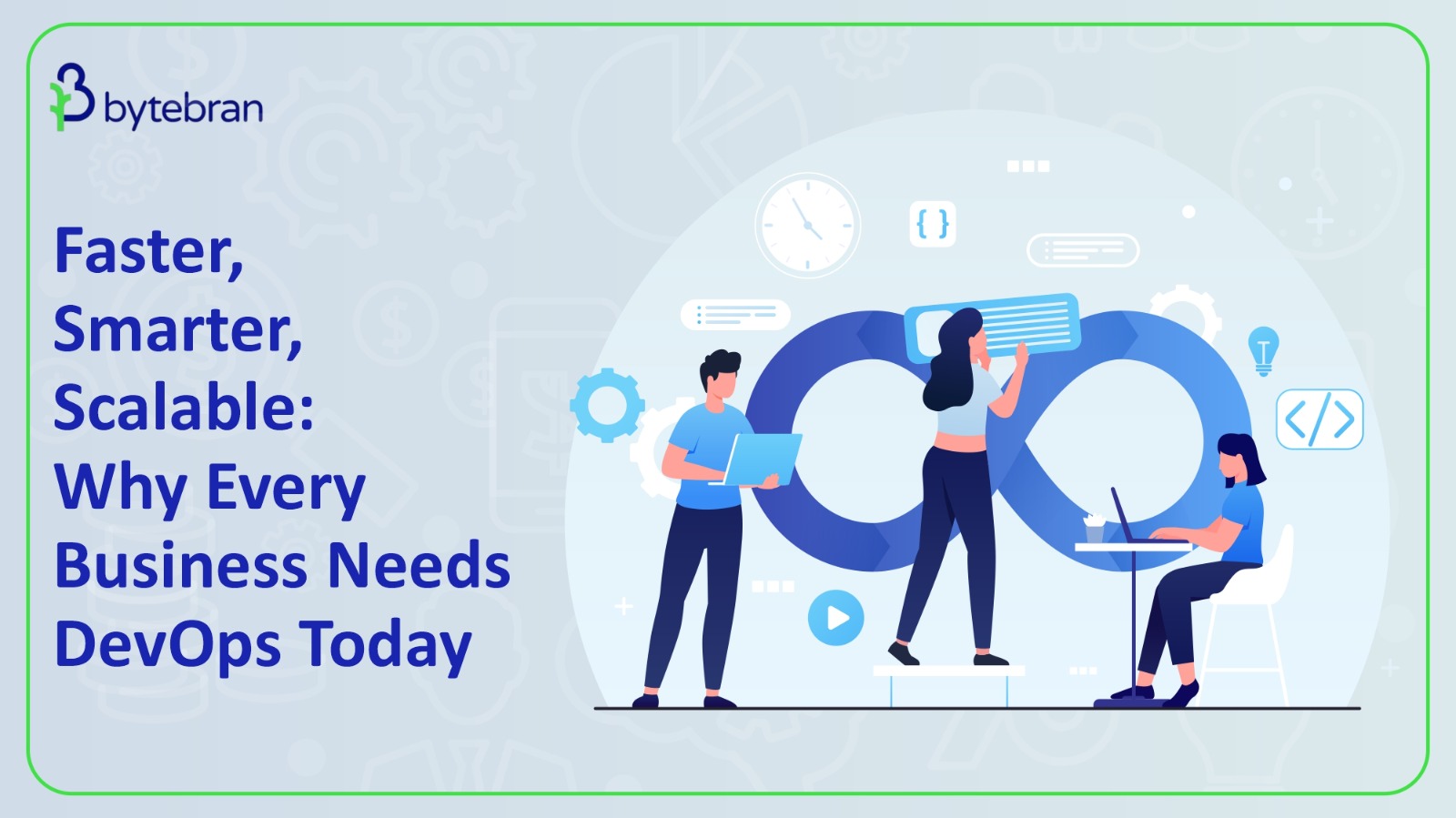Faster, Smarter, Scalable: Why Every Business Needs DevOps Today
Modern businesses must handle exceptional speed requirements to deliver premium software products alongside secure and dependable services in today’s digital environment. The transformative DevOps approach creates a bridge between development and operations teams, which help organizations, deploy software faster and with better reliability. This extensive report defines DevOps as a fundamental business requirement that exists beyond its status as a competitive edge for organizations spanning different sizes and industries.
Understanding DevOps: Beyond the Buzzword
DevOps exceeds its standard practice and tools because it represents an organizational cultural transformation in development and operations methodology. Integrating Development aka Dev and Operations aka Ops forms DevOps, which helps organizations shorten development cycles and deliver frequent updates at reliable scales. The DevOps philosophy exists to eliminate traditional team boundaries so teams can work together while implementing automation and shared accountability. The combination of DevOps creates an uninterrupted value chain that moves ideas to production so organizations can adapt quickly to market shifts and customer requirements. DevOps extends beyond tech companies and benefits all organizations that depend on software delivery. Its principles and practices offer advantages to all organizations that deliver software-based products or services because, today, most businesses operate this way.
The Business Case for DevOps Implementation
The strong business argument for implementing DevOps goes beyond technical enhancements. Multiple studies show that organizations can achieve concrete business results directly influencing financial performance. According to the 2023 State of DevOps Report, Elite DevOps organizations deploy code at a rate 208 times higher than low-performing organizations while achieving a deployment lead time that is 106 times shorter. High-performance teams manage incidents 2,604 times faster and experience a seven times lower failure rate in changes.
The technical metrics directly generate business value through:
Higher speeds to market new features and products enable faster delivery.
- Improved quality and reliability of digital services
- Enhanced customer satisfaction and retention
- More efficient resource utilization
- Greater innovation capacity through experimentation
- Reduced risk through security integration (DevSecOps)
Organizations that operate DevOps successfully demonstrate up to 50% better developer productivity, 60% faster delivery times, and operational optimization ranging from 15% to 30%. These enhancements lead to better business profitability and improved competitive standing.
Key DevOps Benefits for Business Growth
-
Enhanced Collaboration and Communication
Through DevOps, organizations eliminate the systemic boundaries that separate development teams from operations and security teams, or business teams. The improved team collaboration produces collective comprehension between departments regarding business targets and customer requirements throughout the organization.
Teams that take ownership of complete features or services function autonomously with full responsibility. Team members acquire wider professional abilities and an expanded understanding of the complete value stream effects of their work activities. The improved transparency between teams enhances operational alignment while minimizing expenses from miscommunications and maintaining a strong focus on delivering value to customers.
Organizations that adopt DevOps methods experience elevated workforce satisfaction and lower technical employee turnover, which becomes a valuable asset in present-day markets, which require skilled developers and engineers.
-
Accelerated Innovation and Time-to-Market
Quick delivery has become a crucial factor that sets businesses apart in modern digital markets. The DevOps methodology lets organizations transform concepts into operational software using continuous integration and continuous delivery (CI/CD) systems. The speed increase delivers rapid solution delivery straight from market opportunity discovery.
DevOps automation removes human touchpoints, reduces mistakes, and builds dependable delivery systems that can be easily repeated. Organizations achieve maximum value when they automate their infrastructure provisioning and deployment so their human resources can work on customer problem solutions.
Through DevOps practices, Amazon, Netflix, and Google conduct thousands of deployments daily, thus maintaining superior speed-to-market compared to their competitors. The speed of iterative development enables organizations to sustain an innovative cycle that traditional development frameworks cannot emulate.
-
Improved Quality and Reliability
DevOps delivers better software reliability through its automated testing features, infrastructure as code, and continuous monitoring, despite popular beliefs that faster development leads to lower quality. Quality checks performed throughout development time result in better outcomes because teams detect issues sooner before they become costlier to resolve. Combining automated testing with infrastructure as code prevents quality issues from appearing in any release and eliminates environment inconsistencies. Real-time application performance monitoring through continuous observation helps teams identify and resolve issues as they happen.
Service reliability and availability reach substantially higher levels because these factors are essential for keeping digital service customers satisfied and retaining them. Organizations with well-developed DevOps methodologies experience production failures at rates of 60-90% below standard while achieving recovery times that are 70% faster than baseline.
-
Cost Optimization and Efficiency
The implementation of DevOps technology creates diverse efficiency improvements, which translate into various cost-saving opportunities.
- Automation tools decrease the human labor needed for recurring activities such as code-building testing and deployment.
- Using infrastructure as code allows organizations to maximize their resources by designing accurate provisioning systems.
- The ongoing monitoring process helps detect system performance weaknesses and discover ways to improve system efficiency.
- The early identification of defects helps businesses lower their expenses related to quality issues.
- The improved stability of systems decreases both emergency maintenance costs and equipment downtime.
According to research findings, organizations that implement DevOps successfully achieve a typical 20% decrease in IT expenses while generating improved delivery results and product quality. Organizations can allocate their cost savings to innovation projects that establish sustainable competitive advantages through growth initiatives.
-
Enhanced Security Posture
DevSecOps enables organizations to enhance their cybersecurity by integrating security measures into DevOps development processes. This approach establishes security responsibilities across the entire organization. Security controls integrated into the CI/CD pipeline identify vulnerabilities and support their resolution before the development cycle reaches its midpoint.
Security scanning tools automatically verify code, dependencies, and infrastructure configurations against established vulnerability lists and compliance standards. Continuous security processes take over periodic gates to reduce risk without slowing down delivery times.
Companies adopting DevSecOps practice methods see their production-reaching security vulnerabilities decrease by 50%, and their security issue resolution speeds increase by 40% after discovery. Enhanced security measures in this period of rising cyber threats and regulatory needs help organizations achieve substantial risk reduction.
-
Implementing DevOps Successfully
Organizations must thoroughly examine their existing condition through various dimensions before starting a DevOps transformation.
- The current inter-team collaboration serves as a measure of cultural readiness. Is there a blame culture?
- Organizations must evaluate their development and operations processes to determine their level of documentation and standardization.
- The organization should evaluate its legacy systems to understand how they could limit potential automation opportunities.
- A skills inventory should identify the DevOps abilities currently within the organizational structure.
- Leadership support: Is there executive sponsorship for the transformation?
The evaluation process enables organizations to pinpoint their main obstacles and advantages for developing an implementation strategy focusing on critical areas. Organizations seek DevOps consulting to receive unbiased assessments and strategic planning that follows their business targets.
Starting Small but Thinking Big
Big-bang implementation methods do not lead to successful DevOps transformations in most cases. Organizations need to select an appropriate pilot project that meets these conditions:
- A motivated, learning-oriented team
- Manageable scope and complexity
- Visible business impact
- Minimal external dependencies
The test program functions as a development space for building abilities and showing worthwhile gathering support for broad implementation. The team’s growing competence enables them to enhance their practices, which will then help them scale to new teams and projects.
Adequate investment in appropriate tools
Tools provide vital acceleration to the DevOps transformation process, primarily through cultural and practice development. The contemporary DevOps solution consists of the following features:
- Version control systems (Git, GitHub, GitLab)
- Continuous integration tools (Jenkins, CircleCI, GitHub Actions)
- Configuration management systems (Ansible, Chef, Puppet)
- Container orchestration platforms (Kubernetes, Docker Swarm)
- Organizations use Terraform and AWS CloudFormation as infrastructure and code tools to manage their systems.
- The monitoring and observability solutions include Prometheus together with Grafana and ELK Stack.
A chosen toolchain must match the organization’s current technology framework, team proficiency, and operational demands. Cloud providers such as AWS, Azure, and Google Cloud supply platform-specific DevOps solutions, which decrease the implementation complexity for organizations using their environments.
Overcoming Common DevOps Challenges
-
Cultural Resistance
The main challenges to achieving DevOps success are cultural rather than technological constraints. The main obstacles preventing DevOps success typically arise from employee concerns about job modifications, their comfort with present operational methods, and doubts regarding innovative approaches to work. Successful implementation of these concerns demands open communication that explains transformation goals and advantages. It also requires active team member participation in new work designs and executives to display collaborative approaches. Recognizing individuals who adopt new changes and celebrations of achievements helps establish a new organizational culture.
-
Legacy Infrastructure and Technical Debt
Organizations face difficulties when trying to implement DevOps practices in environments with substantial technical debt and legacy systems that were never designed for automation. The requirement demands practical solutions that involve the step-by-step conversion of essential system components for automation integration. The implementation of abstraction layers functions as a method to protect legacy systems. DevOps methods are implemented in new development projects that operate under separate procedures to maintain legacy systems. Implementing infrastructure as code incrementally-These methods help organizations achieve progress by handling realistic constraints even though they do not provide the complete benefits of DevOps at once.
-
Skills and Resource Constraints
Organizations across the board face significant difficulties because of the DevOps talent shortage. The development of capabilities requires the following combination:
- Training existing staff members and providing new skills to enhance their capabilities.
- Strategic hiring for critical skills
- Engaging DevOps consulting partners for knowledge transfer
- The organization must develop communities that allow members to exchange learning knowledge.
- Managed DevOps solutions should be used to enhance internal capabilities.
Such an extensive methodology develops enduring internal capabilities while keeping the transformation active.
Conclusion: DevOps as a Competitive Necessity
DevOps has shifted from being a strategic differentiator to an essential requirement for businesses that need digital capabilities to deliver value in their industries. Organizations that do not implement these practices allow their competitors to surpass them by providing innovations with better quality at reduced costs and faster speeds.
Modern business leaders must determine the speed and quality of their DevOps implementation to satisfy digital business requirements. A successful digital business transformation establishes organizations that can prosper in increasingly competitive and changing markets.
Organizations that center their DevOps transformation on business outcomes instead of particular tools achieve more meaningful value delivery at each development phase. The digital era provides organizations with substantial business improvement potential by developing their DevOps capabilities through internal development, external consulting, or managed solutions.









